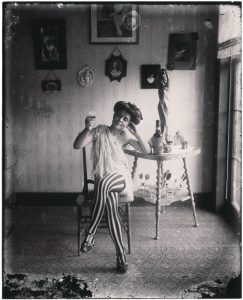Natasha Tretheway’s poem “Photograph of a Bawd Drinking Raleigh Rye” mostly describes a prostitute in one of E.J. Bellocq’s photographs of the same name. It ranges from her clothes, to her hair, to her surroundings. Tretheway comments on her necklace, armpit hair, and even the roundness of her cheeks. As a prostitute, she is accustomed to being scrutinized, and the photo and the poem continue this scrutiny. The photo reduces her to a consumable object much like the women captured on the wall behind her, and the statue of a woman on the table next to her.
There are a few lines that stand out from this close observation that change the poem’s meaning. Tretheway writes that the woman in the photograph raises the glass in her hand, “toasting, perhaps, the viewer you become taking her in”. The last few lines add to this: “It’s easy to see this is all about desire, how it recurs – each time you look, it’s the same moments, the hands of the clock still locked at high noon.”
Referencing the viewer personalizes the photograph. The viewer, and now the reader, are called upon to notice themselves in this experience. They have become the consumer. It is suggested that the woman acknowledges this by toasting the reader’s consumption of her image. It is no longer an impersonal experience; it becomes personal to both the product and the consumer. Both are now aware of the way that the woman has been objectified for viewing pleasure, and by the time you’ve seen the photo it is too late to stop yourself from participating in her objectification.
It is all about desire, as Tretheway claims. The woman cannot be anything more than an object of desire in this photo, because that is what the photo has made her. Just like the women in the frames behind her, and the woman made into a statue, they are all turned into something meant for others. A photo cannot capture all of who someone is, so it reduces them to only what is seen in the moment.
The acknowledgements within these few lines humanize the woman. They remind us that she is more than we can see, more than we can ever know. The piece of this woman shown in the photo is stuck in the position she has been placed in, like the hands of the clock are stuck in their own positions, forever at high noon.
I think this is an interesting perspective, but I also think that there is a defiance in her view of the camera. She is looking directly at the camera and challenges them to view her as an object Bellocq tries to make her into through the camera.